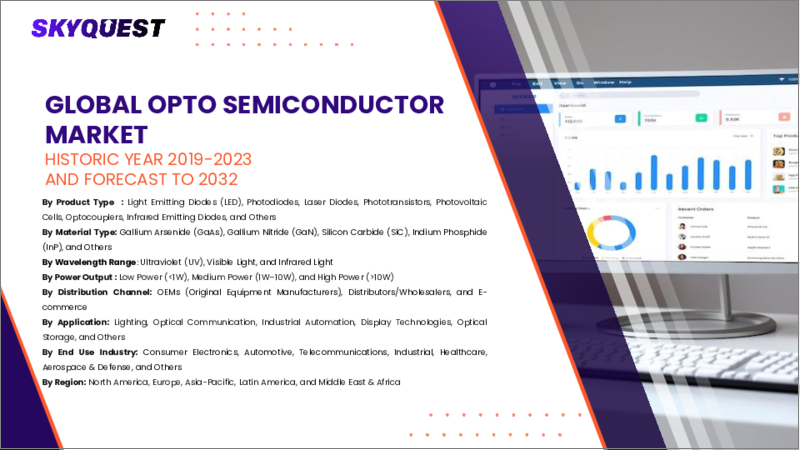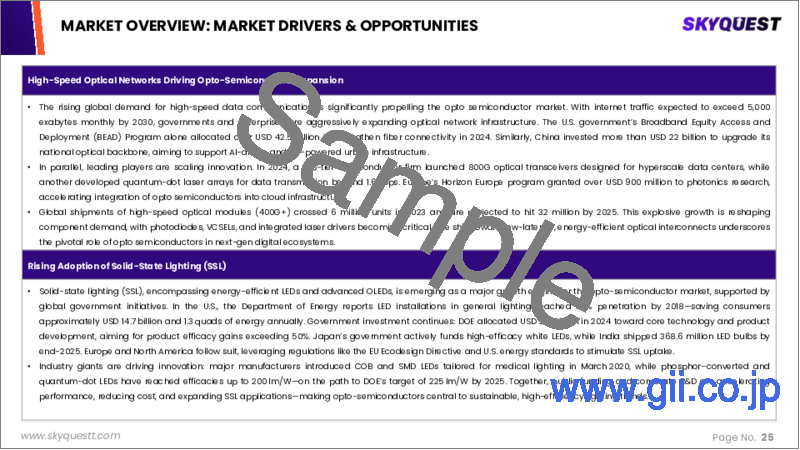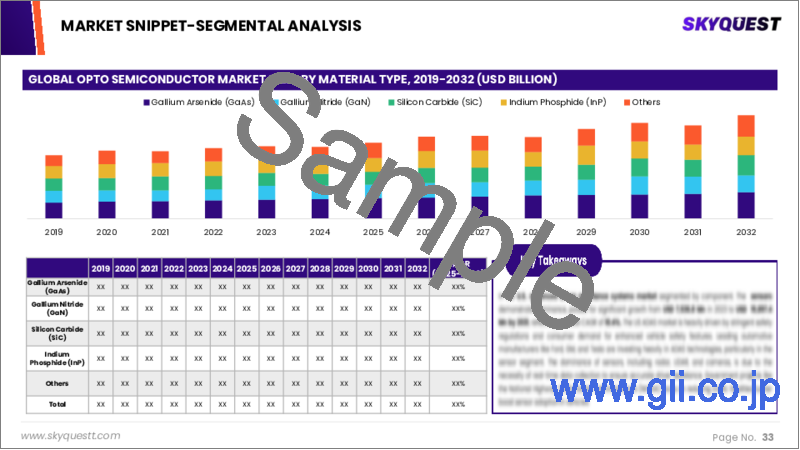|
|
市場調査レポート
商品コード
1629040
光半導体市場規模、シェア、成長分析、タイプ別、波長別、エンドユーザー業界別、地域別 - 産業予測、2025-2032年Opto Semiconductor Market Size, Share, Growth Analysis, By Type (Light Emitting Diodes (LED), Photodiodes), By Wavelength (UV (Ultraviolet), Visible), By End User Industry, By Region - Industry Forecast 2025-2032 |
||||||
|
|||||||
| 光半導体市場規模、シェア、成長分析、タイプ別、波長別、エンドユーザー業界別、地域別 - 産業予測、2025-2032年 |
|
出版日: 2025年01月05日
発行: SkyQuest
ページ情報: 英文 239 Pages
納期: 3~5営業日
|
- 全表示
- 概要
- 目次
光半導体の世界市場規模は、2023年に1,223億米ドルと評価され、2024年の1,280億5,000万米ドルから2032年には1,849億米ドルに成長し、予測期間中(2025-2032年)のCAGRは4.7%で成長する見通しです。
世界の光半導体市場は、民生用エレクトロニクスや自動車分野での採用増が原動力となって大きく成長しています。インダストリー4.0構想やスマートインフラ開発により、特に自動車産業の進化に欠かせないLEDやイメージセンサソリューションに大きなビジネスチャンスが生まれています。家電需要の高まりは、LED照明やレーザーダイオードを含む高度な光半導体技術の必要性を強調しています。自動運転車やマルチカメラ搭載スマートフォンの普及に加え、セキュリティ、監視、ヘルスケアのニーズが高まっているため、イメージセンサーはますます重要になっています。米国、中国、日本などの主要国は次世代アプリケーションを開拓し、市場ダイナミクスを高めているが、アジア太平洋地域は採用率でリードしています。市場競争は依然として激しく、豊富なリソースとイノベーション能力を持つプレーヤーが有利です。
目次
イントロダクション
- 調査の目的
- 調査範囲
- 定義
調査手法
- 情報調達
- 二次データと一次データの方法
- 市場規模予測
- 市場の前提条件と制限
エグゼクティブサマリー
- 世界市場の見通し
- 供給と需要の動向分析
- セグメント別機会分析
市場力学と見通し
- 市場概要
- 市場規模
- 市場力学
- 促進要因と機会
- 抑制要因と課題
- ポーターの分析
主な市場の考察
- 重要成功要因
- 競合の程度
- 主な投資機会
- 市場エコシステム
- 市場の魅力指数(2024年)
- PESTEL分析
- マクロ経済指標
- バリューチェーン分析
- 価格分析
- 技術分析
- 規制分析
- 特許分析
- ケーススタディ分析
光半導体市場規模:タイプ別
- 市場概要
- 発光ダイオード(LED)
- フォトダイオード
- レーザーダイオード
- フォトトランジスタ
- 太陽電池
- オプトカプラ
- 赤外線発光ダイオード
- その他
光半導体市場規模:波長別
- 市場概要
- UV(紫外線)
- 可視
- IR(赤外線)
光半導体市場規模:エンドユーザー業界別
- 市場概要
- 家電
- 自動車
- 通信
- 産業
- ヘルスケア
- 照明
- 軍事および航空宇宙
- その他
光半導体市場規模
- 北米
- 米国
- カナダ
- 欧州
- ドイツ
- スペイン
- フランス
- 英国
- イタリア
- その他欧州地域
- アジア太平洋地域
- 中国
- インド
- 日本
- 韓国
- その他アジア太平洋地域
- ラテンアメリカ
- ブラジル
- その他ラテンアメリカ地域
- 中東・アフリカ
- GCC諸国
- 南アフリカ
- その他中東・アフリカ
競合情報
- 上位5社の比較
- 主要企業の市場ポジショニング(2024年)
- 主な市場企業が採用した戦略
- 市場の最近の動向
- 企業の市場シェア分析(2024年)
- 主要企業の企業プロファイル
- 会社概要
- 製品ポートフォリオ分析
- セグメント別シェア分析
- 収益の前年比比較(2022-2024)
主要企業プロファイル
- Nichia Corporation(Japan)
- OSRAM Opto Semiconductors(Germany)
- CREE, Inc.(US)
- Samsung Electronics Co., Ltd.(South Korea)
- Lumentum Holdings Inc.(US)
- Texas Instruments Incorporated(US)
- ON Semiconductor Corporation(US)
- Sony Corporation(Japan)
- Finisar Corporation(US)
- Vishay Intertechnology, Inc.(US)
- Everlight Electronics Co., Ltd.(Taiwan)
- ROHM Semiconductor(Japan)
- STMicroelectronics N.V.(Switzerland)
- Broadcom Inc.(US)
- Infineon Technologies AG(Germany)
- Panasonic Corporation(Japan)
- LG Innotek Co., Ltd.(South Korea)
- Epistar Corporation(Taiwan)
- AMS AG(Austria)
- Avago Technologies(US)
結論と推奨事項
Global Opto Semiconductor Market size was valued at USD 122.3 billion in 2023 and is poised to grow from USD 128.05 billion in 2024 to USD 184.9 billion by 2032, growing at a CAGR of 4.7% during the forecast period (2025-2032).
The global opto semiconductors market is witnessing significant growth, driven by rising adoption in consumer electronics and automotive sectors. Industry 4.0 initiatives and smart infrastructure developments create vast opportunities, particularly for LED and image sensor solutions, crucial for the automotive industry's evolution. The heightened consumer electronics demand emphasizes the need for advanced opto semiconductor technologies, including LED lighting and laser diodes. Image sensors are increasingly critical due to the proliferation of self-driving vehicles and multi-camera smartphones, alongside rising needs in security, surveillance, and healthcare. Leading economies like the U.S., China, and Japan are pioneering next-gen applications, uplifting market dynamics, while Asia-Pacific leads in adoption rates. Competition remains intense in the market, favoring players with substantial resources and innovation capacities.
Top-down and bottom-up approaches were used to estimate and validate the size of the Global Opto Semiconductor market and to estimate the size of various other dependent submarkets. The research methodology used to estimate the market size includes the following details: The key players in the market were identified through secondary research, and their market shares in the respective regions were determined through primary and secondary research. This entire procedure includes the study of the annual and financial reports of the top market players and extensive interviews for key insights from industry leaders such as CEOs, VPs, directors, and marketing executives. All percentage shares split, and breakdowns were determined using secondary sources and verified through Primary sources. All possible parameters that affect the markets covered in this research study have been accounted for, viewed in extensive detail, verified through primary research, and analyzed to get the final quantitative and qualitative data.
Global Opto Semiconductor Market Segmental Analysis
Global Opto Semiconductor Market is segmented by Type, Wavelength, End User Industry and region. Based on Type, the market is segmented into Light Emitting Diodes (LED), Photodiodes, Laser Diodes, Phototransistors, Photovoltaic Cells, Optocouplers, Infrared Emitting Diodes and Others. Based on Wavelength, the market is segmented into UV (Ultraviolet), Visible and IR (Infrared). Based on End User Industry, the market is segmented into Consumer Electronics, Automotive, Telecommunications, Industrial, Healthcare, Lighting, Military and Aerospace and Others. Based on region, the market is segmented into North America, Europe, Asia Pacific, Latin America and Middle East & Africa.
Driver of the Global Opto Semiconductor Market
The Global Opto Semiconductor market is significantly propelled by the growing demand for energy efficiency across multiple sectors. Industries are increasingly prioritizing sustainable solutions, and opto semiconductor technologies, especially light-emitting diodes (LEDs), are at the forefront of this shift. LEDs provide remarkable energy savings when contrasted with conventional lighting options, leading to their widespread adoption. As businesses and consumers alike recognize the importance of reducing energy consumption and lowering utility costs, the appeal of opto semiconductors continues to rise. This trend is expected to further bolster market growth, as stakeholders seek innovative technologies that align with sustainability goals.
Restraints in the Global Opto Semiconductor Market
The global opto semiconductor market faces several restraints, primarily stemming from intellectual property rights and patent-related challenges. Disputes over patents can lead to significant legal issues, imposing hefty licensing fees that burden companies and stifle innovation. These complications create obstacles for businesses striving to compete and advance in this dynamic sector. As a result, the potential for growth within the market may be hindered, as firms grapple with the complexities of navigating intellectual property laws while trying to develop and introduce new technologies. Hence, resolving such issues is crucial for fostering a more competitive and innovative opto semiconductor landscape.
Market Trends of the Global Opto Semiconductor Market
The Global Opto Semiconductor market is witnessing a robust trend driven by the escalating demand for low-power components across diverse electronic devices. As technology pervades daily life-from consumer electronics to industrial applications-manufacturers are prioritizing energy-efficient solutions to meet sustainability goals and regulatory requirements. This shift not only enhances device performance but also aligns with the growing consumer preference for eco-friendly products. Innovations in opto semiconductors, including advancements in materials and fabrication techniques, are expected to further bolster market growth. Additionally, the rising adoption of IoT devices and smart technologies will likely amplify the need for high-performance opto semiconductors in the coming years.
Table of Contents
Introduction
- Objectives of the Study
- Scope of the Report
- Definitions
Research Methodology
- Information Procurement
- Secondary & Primary Data Methods
- Market Size Estimation
- Market Assumptions & Limitations
Executive Summary
- Global Market Outlook
- Supply & Demand Trend Analysis
- Segmental Opportunity Analysis
Market Dynamics & Outlook
- Market Overview
- Market Size
- Market Dynamics
- Drivers & Opportunities
- Restraints & Challenges
- Porters Analysis
- Competitive rivalry
- Threat of substitute
- Bargaining power of buyers
- Threat of new entrants
- Bargaining power of suppliers
Key Market Insights
- Key Success Factors
- Degree of Competition
- Top Investment Pockets
- Market Ecosystem
- Market Attractiveness Index, 2024
- PESTEL Analysis
- Macro-Economic Indicators
- Value Chain Analysis
- Pricing Analysis
- Technology Analysis
- Regulatory Analysis
- Patent Analysis
- Case Study Analysis
Global Opto Semiconductor Market Size by Type & CAGR (2025-2032)
- Market Overview
- Light Emitting Diodes (LED)
- Photodiodes
- Laser Diodes
- Phototransistors
- Photovoltaic Cells
- Optocouplers
- Infrared Emitting Diodes
- Others
Global Opto Semiconductor Market Size by Wavelength & CAGR (2025-2032)
- Market Overview
- UV (Ultraviolet)
- Visible
- IR (Infrared)
Global Opto Semiconductor Market Size by End User Industry & CAGR (2025-2032)
- Market Overview
- Consumer Electronics
- Automotive
- Telecommunications
- Industrial
- Healthcare
- Lighting
- Military and Aerospace
- Others
Global Opto Semiconductor Market Size & CAGR (2025-2032)
- North America (Type, Wavelength, End User Industry)
- US
- Canada
- Europe (Type, Wavelength, End User Industry)
- Germany
- Spain
- France
- UK
- Italy
- Rest of Europe
- Asia Pacific (Type, Wavelength, End User Industry)
- China
- India
- Japan
- South Korea
- Rest of Asia-Pacific
- Latin America (Type, Wavelength, End User Industry)
- Brazil
- Rest of Latin America
- Middle East & Africa (Type, Wavelength, End User Industry)
- GCC Countries
- South Africa
- Rest of Middle East & Africa
Competitive Intelligence
- Top 5 Player Comparison
- Market Positioning of Key Players, 2024
- Strategies Adopted by Key Market Players
- Recent Developments in the Market
- Company Market Share Analysis, 2024
- Company Profiles of All Key Players
- Company Details
- Product Portfolio Analysis
- Company's Segmental Share Analysis
- Revenue Y-O-Y Comparison (2022-2024)
Key Company Profiles
- Nichia Corporation (Japan)
- Company Overview
- Business Segment Overview
- Financial Updates
- Key Developments
- OSRAM Opto Semiconductors (Germany)
- Company Overview
- Business Segment Overview
- Financial Updates
- Key Developments
- CREE, Inc. (US)
- Company Overview
- Business Segment Overview
- Financial Updates
- Key Developments
- Samsung Electronics Co., Ltd. (South Korea)
- Company Overview
- Business Segment Overview
- Financial Updates
- Key Developments
- Lumentum Holdings Inc. (US)
- Company Overview
- Business Segment Overview
- Financial Updates
- Key Developments
- Texas Instruments Incorporated (US)
- Company Overview
- Business Segment Overview
- Financial Updates
- Key Developments
- ON Semiconductor Corporation (US)
- Company Overview
- Business Segment Overview
- Financial Updates
- Key Developments
- Sony Corporation (Japan)
- Company Overview
- Business Segment Overview
- Financial Updates
- Key Developments
- Finisar Corporation (US)
- Company Overview
- Business Segment Overview
- Financial Updates
- Key Developments
- Vishay Intertechnology, Inc. (US)
- Company Overview
- Business Segment Overview
- Financial Updates
- Key Developments
- Everlight Electronics Co., Ltd. (Taiwan)
- Company Overview
- Business Segment Overview
- Financial Updates
- Key Developments
- ROHM Semiconductor (Japan)
- Company Overview
- Business Segment Overview
- Financial Updates
- Key Developments
- STMicroelectronics N.V. (Switzerland)
- Company Overview
- Business Segment Overview
- Financial Updates
- Key Developments
- Broadcom Inc. (US)
- Company Overview
- Business Segment Overview
- Financial Updates
- Key Developments
- Infineon Technologies AG (Germany)
- Company Overview
- Business Segment Overview
- Financial Updates
- Key Developments
- Panasonic Corporation (Japan)
- Company Overview
- Business Segment Overview
- Financial Updates
- Key Developments
- LG Innotek Co., Ltd. (South Korea)
- Company Overview
- Business Segment Overview
- Financial Updates
- Key Developments
- Epistar Corporation (Taiwan)
- Company Overview
- Business Segment Overview
- Financial Updates
- Key Developments
- AMS AG (Austria)
- Company Overview
- Business Segment Overview
- Financial Updates
- Key Developments
- Avago Technologies (US)
- Company Overview
- Business Segment Overview
- Financial Updates
- Key Developments






